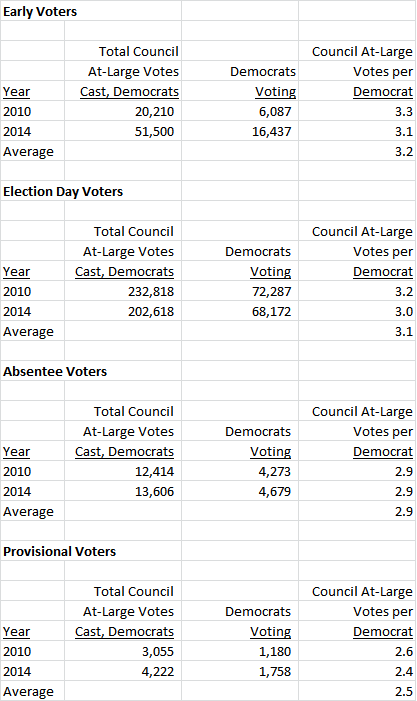By Adam Pagnucco.
In the Montgomery County Council At-Large race, voters can vote for up to four candidates and the leading four vote-getters win. That gives candidates a lot of ways to get votes. A common statement heard from candidates is, “You have four votes to cast. There are a lot of good candidates in this race. I hope I can earn one of your votes.”
But that statement, while politically appealing, doesn’t actually reflect the reality of at-large voting. Lots of voters don’t cast four votes in the at-large race. On average, they cast only three.
The chart below shows the total number of Council At-Large votes cast in Democratic primaries and the total number of Democrats voting over the last five cycles. If everyone was casting four at-large votes, the number of at-large votes divided by the number of voters should be four. Instead, the ratio of at-large votes to voters ranges from 3.0 to 3.2, averaging 3.1. That tight range holds regardless of the number of candidates running and the presence of open seats.
What about the timing of votes? The conventional wisdom is that early voters are unusually well informed, know exactly who they’re voting for and can’t wait to vote. If anyone would be willing and able to use all four of their at-large votes, it should be early voters. But in fact, that isn’t true. There is not much difference between early voters, election day voters and absentee voters in terms of how many at-large votes they cast. All of them are right around three each, with provisional voters coming in near 2.5.
Why does this happen? Now we’re in the realm of speculation. Here is a theory. For all its importance to the function of county government, the Council At-Large race is seen by many as a down-ballot affair. It doesn’t attract the attention of races for Congress, Governor and Executive. It competes with state legislative and council district races in the voters’ mail, Facebook feeds and email inboxes. The name recognition of incumbents is modest. (How many voters can actually name all their Council Members?)
Now think about the voting process of the average voter. Perhaps the voter was aided by At-Large Incumbent X in some way, maybe through constituent service or a vote on a bill, master plan or budget item. The voter really likes X and will vote for him. Next, perhaps a voter will pick At-Large Candidate Y because she was endorsed by the Washington Post, the teachers or the Sierra Club. And then perhaps the voter will pick At-Large Candidate Z because a neighbor said something nice about him or handed her his lit. Or maybe Z knocked on the voter’s door. Or maybe Z lives in the same community as the voter. Or maybe Z is the only other candidate the voter recognizes. Or maybe… you get the idea. Often, these voting decisions do not involve great strategic deliberation or deep research on the candidates.
But there is one more variable to examine: geography. We have previously written that Democrats in Downcounty areas, especially those in the Democratic Crescent (Cabin Branch, Bethesda, Chevy Chase, Kensington, Downtown Silver Spring and Takoma Park) are much more likely to vote in mid-term primaries than Upcounty Democrats. Do Democrats in Downcounty vote for more at-large candidates than those in Upcounty? We’ll find out in Part Two.


